Towards a Holistic Approach for UAV-Based Large-Scale Photovoltaic Inspection: A Review on Deep Learning and Image Processing Techniques
Abstract
1. Introduction
1.1. Types of Anomalies and Detection Methods
1.2. UAVs as a Fast Inspection Tool
1.3. Image Processing Techniques for Anomaly Classification
1.3.1. Conventional Methods
1.3.2. AI-Based Methods
- Training and finetuning:
- Generalization and optimization for real-time applications:
1.4. Aims, Contributions, and Paper Organization
2. Guidelines and Best Practices for UAV Data Acquisition in PV Inspection
3. Data Preprocessing and Preparation for the Inspection
3.1. UAV Image Pre-Processing
3.2. Image Geolocation
3.3. Addressing Data Imbalance and Augmentation
4. Photovoltaic Module Segmentation and Identification
5. Deep Learning for Anomaly Detection and Classification Using UAV Images
6. Challenges in Model Generalization and Domain Adaptation
7. Towards a Holistic Approach for End-to-End UAV-Based PV Inspection Workflow
8. Critical Analysis and Future Research Directions
9. Conclusions
Author Contributions
Funding
Acknowledgments
Conflicts of Interest
Abbreviations
| AI | Artificial Intelligence |
| CNN | Convolutional Neural Network |
| DBSCAN | Density-Based Spatial Clustering of Applications with Noise |
| DC | Direct Current |
| DL | Deep Learning |
| EL | Electroluminescence |
| EVA | Ethylene Vinyl Acetate |
| FPN-DensNet | Feature Pyramid Network with DenseNet |
| GSD | Ground Sampling Distance |
| GW | Gigawatt |
| GWp | Gigawatt-peak |
| HSV | Hue, Saturation, Value |
| ID | Identifier |
| IEC | International Electrotechnical Commission |
| IR | Infrared |
| KNN | K-Nearest Neighbors |
| ML | Machine Learning |
| MVS | Multi-View Stereo |
| ORB | Oriented FAST and Rotated BRIEF |
| PV | Photovoltaic |
| RANSAC | Random Sample Consensus |
| RCNN | Region-based Convolutional Neural Network |
| RGB | Red, Green, Blue |
| ROI | Return on Investment |
| SFM | Structure from Motion |
| SMOTE | Synthetic Minority Over-sampling Technique |
| SOTA | State of the Art |
| SSD | Single Shot MultiBox Detector |
| STC | Standard Test Conditions |
| SVM | Support Vector Machine |
| UAV | Unmanned Aerial Vehicle |
| UNET | U-Net Neural Network Architecture |
| UV | Ultraviolet |
| VGG | Visual Geometry Group (Deep Learning Model) |
References
- Masson, G.; de l’Epine, M.; Kaizuka, I. Trends in PV Applications 2024; IEA PVPS: Paris, France, 2024. [Google Scholar] [CrossRef]
- IEA Renewables 2023. Available online: https://www.iea.org/reports/renewables-2023 (accessed on 1 October 2024).
- Dambhare, M.V.; Butey, B.; Moharil, S.V. Solar Photovoltaic Technology: A Review of Different Types of Solar Cells and Its Future Trends. J. Phys. Conf. Ser. 2021, 1913, 012053. [Google Scholar] [CrossRef]
- Osmani, K.; Haddad, A.; Lemenand, T.; Castanier, B.; Alkhedher, M.; Ramadan, M. A Critical Review of PV Systems’ Faults with the Relevant Detection Methods. Energy Nexus 2023, 12, 100257. [Google Scholar] [CrossRef]
- Rahman, T.; Mansur, A.A.; Hossain Lipu, M.S.; Rahman, M.S.; Ashique, R.H.; Houran, M.A.; Elavarasan, R.M.; Hossain, E. Investigation of Degradation of Solar Photovoltaics: A Review of Aging Factors, Impacts, and Future Directions toward Sustainable Energy Management. Energies 2023, 16, 3706. [Google Scholar] [CrossRef]
- Lorenzo, G.D.; Araneo, R.; Mitolo, M.; Niccolai, A.; Grimaccia, F. Review of O&M Practices in PV Plants: Failures, Solutions, Remote Control, and Monitoring Tools. IEEE J. Photovolt. 2020, 10, 914–926. [Google Scholar] [CrossRef]
- Lowin, M.; Kellner, D.; Kohl, T.; Mihale-Wilson, C. From Physical to Virtual: Leveraging Drone Imagery to Automate Photovoltaic System Maintenance; Gesellschaft für Informatik: Bonn, Germany, 2021; Volume 1. [Google Scholar] [CrossRef]
- Aghaei, M.; Fairbrother, A.; Gok, A.; Ahmad, S.; Kazim, S.; Lobato, K.; Oreski, G.; Reinders, A.; Schmitz, J.; Theelen, M.; et al. Review of Degradation and Failure Phenomena in Photovoltaic Modules. Renew. Sustain. Energy Rev. 2022, 159, 112160. [Google Scholar] [CrossRef]
- Sarikh, S.; Raoufi, M.; Bennouna, A.; Benlarabi, A.; Ikken, B. Fault Diagnosis in a Photovoltaic System through I-V Characteristics Analysis. In Proceedings of the 2018 9th International Renewable Energy Congress, IREC 2018, Hammamet, Tunisia, 20–22 March 2018; Institute of Electrical and Electronics Engineers Inc.: Piscataway, NJ, USA, 2018; pp. 1–6. [Google Scholar]
- Haque, A.; Bharath, K.V.S.; Khan, M.A.; Khan, I.; Jaffery, Z.A. Fault Diagnosis of Photovoltaic Modules. Energy Sci. Eng. 2019, 7, 622–644. [Google Scholar] [CrossRef]
- Zhang, Z.; Ma, M.; Wang, H.; Wang, H.; Ma, W.; Zhang, X. A Fault Diagnosis Method for Photovoltaic Module Current Mismatch Based on Numerical Analysis and Statistics. Sol. Energy 2021, 225, 221–236. [Google Scholar] [CrossRef]
- Sepúlveda-Oviedo, E.H.; Travé-Massuyès, L.; Subias, A.; Pavlov, M.; Alonso, C. Fault Diagnosis of Photovoltaic Systems Using Artificial Intelligence: A Bibliometric Approach. Heliyon 2023, 9, e21491. [Google Scholar] [CrossRef]
- Santiago, S.; Aissa, C.; Engin, K. Automatic Fault Detection in Grid Connected PV Systems. Sol. Energy 2013, 94, 119–127. [Google Scholar] [CrossRef]
- Toubal Maamar, A.e.; Ladjouzi, S.; Taleb, R.; Kacemi, Y. Détection et Classification de Défauts Pour Un GPV: Etude Comparative Entre La Méthode de Seuillage et Réseaux de Neurones. Revue Des. Energ. Renouvelables 2018, 21, 45–53. [Google Scholar]
- Iqbal, M.S.; Niazi, Y.A.K.; Amir Khan, U.; Lee, B.W. Real-Time Fault Detection System for Large Scale Grid Integrated Solar Photovoltaic Power Plants. Int. J. Electr. Power Energy Syst. 2021, 130, 106902. [Google Scholar] [CrossRef]
- Hijjawi, U.; Lakshminarayana, S.; Xu, T.; Piero Malfense Fierro, G.; Rahman, M. A Review of Automated Solar Photovoltaic Defect Detection Systems: Approaches, Challenges, and Future Orientations. Sol. Energy 2023, 266, 112186. [Google Scholar] [CrossRef]
- Carletti, V.; Greco, A.; Saggese, A.; Vento, M. An Intelligent Flying System for Automatic Detection of Faults in Photovoltaic Plants. J. Ambient. Intell. Humaniz. Comput. 2020, 11, 2027–2040. [Google Scholar] [CrossRef]
- Liao, K.-C.; Lu, J.-H. Using UAV to Detect Solar Module Fault Conditions of a Solar Power Farm with IR and Visual Image Analysis. Appl. Sci. 2021, 11, 1835. [Google Scholar] [CrossRef]
- Afifah, A.N.N.; Indrabayu; Suyuti, A.; Syafaruddin. A Review on Image Processing Techniques for Damage Detection on Photovoltaic Panels. ICIC Express Lett. 2021, 15, 779–790. [Google Scholar] [CrossRef]
- IEA-PVPS. Qualification of Photovoltaic (PV) Power Plants Using Mobile Test Equipment Report; IEA-PVPS T13-24:2021; IEA-PVPS: Rome, Italy, 2021. [Google Scholar]
- Al-Mashhadani, R.; Alkawsi, G.; Mohamed, Y.; Alkahtani, A.; Nordin, F.H.; Hashim, W.; Kiong, T. Deep Learning Methods for Solar Fault Detection and Classification: A Review. Inf. Sci. Lett. 2021, 10, 323. [Google Scholar] [CrossRef]
- Köntges, M.; Kunze, I.; Kajari-Schrder, S.; Breitenmoser, X.; Bjørneklett, B. The Risk of Power Loss in Crystalline Silicon Based Photovoltaic Modules Due to Micro-Cracks. Sol. Energy Mater. Sol. Cells 2011, 95, 1131–1137. [Google Scholar] [CrossRef]
- Abdulmawjood, K.; Refaat, S.S.; Morsi, W.G. Detection and Prediction of Faults in Photovoltaic Arrays: A Review. In Proceedings of the 2018 IEEE 12th International Conference on Compatibility, Power Electronics and Power Engineering, CPE-POWERENG 2018, Doha, Qatar, 10–12 April 2018; Institute of Electrical and Electronics Engineers Inc.: Piscataway, NJ, USA, 2018; pp. 1–8. [Google Scholar]
- Triki-Lahiani, A.; Bennani-Ben Abdelghani, A.; Slama-Belkhodja, I. Fault Detection and Monitoring Systems for Photovoltaic Installations: A Review. Renew. Sustain. Energy Rev. 2018, 82, 2680–2692. [Google Scholar] [CrossRef]
- Köntges, M.; Kurtz, S.; Packard, C.; Jahn, U.; Berger, K.A.; Kato, K.; Friesen, T.; Liu, H.; Van Iseghem, M. Review of Failures of Photovoltaic Modules; IEA International Energy Agency: Paris, France, 2014. [Google Scholar]
- Mehta, S.; Azad, A.P.; Chemmengath, S.A.; Raykar, V.; Kalyanaraman, S. DeepSolarEye: Power Loss Prediction and Weakly Supervised Soiling Localization via Fully Convolutional Networks for Solar Panels. In Proceedings of the 2018 IEEE Winter Conference on Applications of Computer Vision, WACV 2018, Lake Tahoe, NA, USA, 12–15 March 2018; Institute of Electrical and Electronics Engineers Inc.: Piscataway, NJ, USA, 2018; Volume 2018, pp. 333–342. [Google Scholar]
- Grimaccia, F.; Leva, S.; Dolara, A.; Aghaei, M. Survey on PV Modules’ Common Faults after an O&M Flight Extensive Campaign over Different Plants in Italy. IEEE J. Photovolt. 2017, 7, 810–816. [Google Scholar] [CrossRef]
- Kandeal, A.W.; Elkadeem, M.R.; Kumar Thakur, A.; Abdelaziz, G.B.; Sathyamurthy, R.; Kabeel, A.E.; Yang, N.; Sharshir, S.W. Infrared Thermography-Based Condition Monitoring of Solar Photovoltaic Systems: A Mini Review of Recent Advances. Sol. Energy 2021, 223, 33–43. [Google Scholar] [CrossRef]
- Zefri, Y.; Sebari, I.; Hajji, H.; Aniba, G. Developing a Deep Learning-Based Layer-3 Solution for Thermal Infrared Large-Scale Photovoltaic Module Inspection from Orthorectified Big UAV Imagery Data. Int. J. Appl. Earth Obs. Geoinf. 2022, 106, 102652. [Google Scholar] [CrossRef]
- Tsanakas, J.A.; Chrysostomou, D.; Botsaris, P.N.; Gasteratos, A. Fault Diagnosis of Photovoltaic Modules through Image Processing and Canny Edge Detection on Field Thermographic Measurements. Int. J. Sustain. Energy 2015, 34, 351–372. [Google Scholar] [CrossRef]
- Kirsten Vidal de Oliveira, A.; Aghaei, M.; Rüther, R. Aerial Infrared Thermography for Low-Cost and Fast Fault Detection in Utility-Scale PV Power Plants. Sol. Energy 2020, 211, 712–724. [Google Scholar] [CrossRef]
- Buerhop, C.; Bommes, L.; Schlipf, J.; Pickel, T.; Fladung, A.; Peters, I.M. Infrared Imaging of Photovoltaic Modules: A Review of the State of the Art and Future Challenges Facing Gigawatt Photovoltaic Power Stations. Prog. Energy 2022, 4, 042010. [Google Scholar] [CrossRef]
- Spagnolo, G.S.; Del Vecchio, P.; Makary, G.; Papalillo, D.; Martocchia, A. A Review of IR Thermography Applied to PV Systems. In Proceedings of the 2012 11th International Conference on Environment and Electrical Engineering, EEEIC 2012, Venice, Italy, 18–25 May 2012; pp. 879–884. [Google Scholar]
- Aghaei, M.; Dolara, A.; Leva, S.; Grimaccia, F. Image Resolution and Defects Detection in PV Inspection by Unmanned Technologies. In Proceedings of the IEEE Power and Energy Society General Meeting, Boston, MA, USA, 17–21 July 2016; IEEE: Piscataway, NJ, USA, 2016; Volume 2016. [Google Scholar] [CrossRef]
- FLIR. A Guide to Inspecting Solar Fields with Thermal Imaging Drones; FLIR: Wilsonville, OR, USA, 2019. [Google Scholar]
- Raptor Maps DJI Mavic 2 Enterprise Advanced—Raptor Maps. Available online: https://raptormaps.com/solar-tech-docs/pv-energy-aerial-thermography-mavic-2-enterprise-adv/ (accessed on 26 July 2023).
- IEC. IEC Technical Specification 62446-3. Available online: https://webstore.iec.ch/en/publication/28628 (accessed on 2 October 2024).
- Zefri, Y.; Imane, S.; Hicham, H.; Ghassane, A.; Bouchini-Idrissi Safia, E. Applied Imagery Pattern Recognition for Photovoltaic Modules’ Inspection: A Review on Methods, Challenges and Future Development. Sustain. Energy Technol. Assess. 2022, 52, 102071. [Google Scholar] [CrossRef]
- Olayiwola, O.; Camara, F. Challenges and Opportunities for Autonomous UAV Inspection in Solar Photovoltaics. E3S Web Conf. 2024, 572, 1003–1011. [Google Scholar] [CrossRef]
- Reich, C.; Swanson, D.; Shimpi, T.; Drayton, J.; Munshi, A.; Abbas, A.; Sampath, W. Passivation of a Cd1-XMgxTe Absorber for Application in a Tandem Cell. In Proceedings of the 2017 IEEE 44th Photovoltaic Specialist Conference, PVSC 2017, Washington, DC, USA, 25–30 June 2017; pp. 2789–2793. [Google Scholar] [CrossRef]
- Ying, Y.; Qi, Y.; Rong, L.; Men, H.; Joo, Y.H. Anchor Points Based Accurate Fault Locating in Large-Scale Photovoltaic Plants via Aerial Infrared Videos. IEEE J. Photovolt. 2022, 12, 437–443. [Google Scholar] [CrossRef]
- Arenella, A.; Greco, A.; Saggese, A.; Vento, M. Real Time Fault Detection in Photovoltaic Cells by Cameras on Drones. In Proceedings of the Image Analysis and Recognition, Montreal, QC, Canada, 5–7 July 2017; Karray, F., Campilho, A., Cheriet, F., Eds.; Springer International Publishing: Cham, Switzerland, 2017; pp. 617–625. [Google Scholar]
- Waqar Akram, M.; Li, G.; Jin, Y.; Chen, X. Failures of Photovoltaic Modules and Their Detection: A Review. Appl. Energy 2022, 313, 118822. [Google Scholar] [CrossRef]
- Yılmaz, A.; Bayrak, G. A Real-Time UWT-Based Intelligent Fault Detection Method for PV-Based Microgrids. Electr. Power Syst. Res. 2019, 177, 105984. [Google Scholar] [CrossRef]
- Jalal, M.; Khalil, I.U.; Haq, A. ul Deep Learning Approaches for Visual Faults Diagnosis of Photovoltaic Systems: State-of-the-Art Review. Results Eng. 2024, 23, 102622. [Google Scholar] [CrossRef]
- Ali, M.; Dewan, A.; Sahu, A.K.; Taye, M.M. Understanding of Machine Learning with Deep Learning: Architectures, Workflow, Applications and Future Directions. Computers 2023, 12, 91. [Google Scholar] [CrossRef]
- Liu, H.; Perera, A.; Al-Naji, A.; Boubaker, S.; Kamel, S.; Ghazouani, N.; Mellit, A. Assessment of Machine and Deep Learning Approaches for Fault Diagnosis in Photovoltaic Systems Using Infrared Thermography. Remote Sens. 2023, 15, 1686. [Google Scholar] [CrossRef]
- Aurélien, G. Hands-On Machine Learning with Scikit-Learn, Keras, and TensorFlow, 2nd ed.; O’Reilly Media, Inc.: Sebastopol, CA, USA, 2019. [Google Scholar]
- He, K.; Zhang, X.; Ren, S.; Sun, J. Deep Residual Learning for Image Recognition. Proc. IEEE Comput. Soc. Conf. Comput. Vis. Pattern Recognit. 2015, 2016, 770–778. [Google Scholar] [CrossRef]
- Hinton, G.E.; Srivastava, N.; Krizhevsky, A.; Sutskever, I.; Salakhutdinov, R.R. Improving Neural Networks by Preventing Co-Adaptation of Feature Detectors. Comput. Sci. 2012, 3, 212–223. [Google Scholar]
- Tian, Y.; Zhang, Y. A Comprehensive Survey on Regularization Strategies in Machine Learning. Inf. Fusion 2022, 80, 146–166. [Google Scholar] [CrossRef]
- Anand, K.; Wang, Z.; Loog, M.; van Gemert, J. Black Magic in Deep Learning: How Human Skill Impacts Network Training. In Proceedings of the 31st British Machine Vision Conference, BMVC 2020, Virtual Event, 7–10 September 2020; British Machine Vision Association, BMVA: Durham, UK, 2020. [Google Scholar]
- Ahmed, W.; Hanif, A.; Kallu, K.D.; Kouzani, A.Z.; Ali, M.U.; Zafar, A. Photovoltaic Panels Classification Using Isolated and Transfer Learned Deep Neural Models Using Infrared Thermographic Images. Sensors 2021, 21, 5668. [Google Scholar] [CrossRef]
- Le, M.; Le, D.V.; Ha Thi Vu, H. Thermal Inspection of Photovoltaic Modules with Deep Convolutional Neural Networks on Edge Devices in AUV. Measurement 2023, 218, 113135. [Google Scholar] [CrossRef]
- Tradacete-Ágreda, M.; Santos-Pérez, C.; Hueros-Barrios, P.J.; Rodríguez-Sánchez, F.J.; Pérez-Seguí, R.; Melero-Deza, J.; Campoy, P. Framework for Autonomous Inspection of PV Plants Using IoT Electronics on Each PV Panel and UAV Collaboration. Energy Convers. Manag. X 2025, 26, 100878. [Google Scholar] [CrossRef]
- Polymeropoulos, I.; Bezyrgiannidis, S.; Vrochidou, E.; Papakostas, G.A. Enhancing Solar Plant Efficiency: A Review of Vision-Based Monitoring and Fault Detection Techniques. Technologies 2024, 12, 175. [Google Scholar] [CrossRef]
- de Oliveira, A.K.V.; Aghaei, M.; Rüther, R. Automatic Inspection of Photovoltaic Power Plants Using Aerial Infrared Thermography: A Review. Energies 2022, 15, 2055. [Google Scholar] [CrossRef]
- Salahat, E.; Asselineau, C.-A.; Coventry, J.; Mahony, R. Waypoint Planning for Autonomous Aerial Inspection of Large-Scale Solar Farms. In Proceedings of the IECON 2019—45th Annual Conference of the IEEE Industrial Electronics Society, Lisbon, Portugal, 14–17 October 2019; pp. 763–769. [Google Scholar]
- Manno, D.; Cipriani, G.; Ciulla, G.; Di Dio, V.; Guarino, S.; Lo Brano, V. Deep Learning Strategies for Automatic Fault Diagnosis in Photovoltaic Systems by Thermographic Images. Energy Convers. Manag. 2021, 241, 114315. [Google Scholar] [CrossRef]
- Jeffrey Kuo, C.F.; Chen, S.H.; Huang, C.Y. Automatic Detection, Classification and Localization of Defects in Large Photovoltaic Plants Using Unmanned Aerial Vehicles (UAV) Based Infrared (IR) and RGB Imaging. Energy Convers. Manag. 2023, 276, 116495. [Google Scholar] [CrossRef]
- Bommes, L.; Hoffmann, M.; Buerhop-Lutz, C.; Pickel, T.; Hauch, J.; Brabec, C.; Maier, A.; Marius Peters, I. Anomaly Detection in IR Images of PV Modules Using Supervised Contrastive Learning. Prog. Photovolt. Res. Appl. 2022, 30, 597–614. [Google Scholar] [CrossRef]
- Venkatesh, S.N.; Sugumaran, V. Fault Detection in Aerial Images of Photovoltaic Modules Based on Deep Learning. IOP Conf. Ser. Mater. Sci. Eng. 2021, 1012, 012030. [Google Scholar] [CrossRef]
- Yao, Y.Y.; Hu, Y.T. Recognition and Location of Solar Panels Based on Machine Vision. In Proceedings of the 2017 2nd Asia-Pacific Conference on Intelligent Robot Systems, ACIRS 2017, Wuhan, China, 16–18 June 2017; pp. 7–12. [Google Scholar] [CrossRef]
- Pathak, S.P.; Patil, S.A. Evaluation of Effect of Pre-Processing Techniques in Solar Panel Fault Detection. IEEE Access 2023, 11, 72848–72860. [Google Scholar] [CrossRef]
- Bakır, H.; Kuzhippallil, F.A.; Merabet, A. Automatic Detection of Deteriorated Photovoltaic Modules Using IRT Images and Deep Learning (CNN, LSTM) Strategies. Eng. Fail. Anal. 2023, 146, 107132. [Google Scholar] [CrossRef]
- Montanez, L.E.; Valentin-Coronado, L.M.; Moctezuma, D.; Flores, G. Photovoltaic Module Segmentation and Thermal Analysis Tool from Thermal Images. In Proceedings of the 2020 IEEE International Autumn Meeting on Power, Electronics and Computing, ROPEC 2020, Ixtapa, Mexico, 4–6 November 2020. [Google Scholar] [CrossRef]
- Pierdicca, R.; Paolanti, M.; Felicetti, A.; Piccinini, F.; Zingaretti, P. Automatic Faults Detection of Photovoltaic Farms: SolAIr, a Deep Learning-Based System for Thermal Images. Energies 2020, 13, 6496. [Google Scholar] [CrossRef]
- Zefri, Y.; Sebari, I.; Hajji, H.; Aniba, G.; Aghaei, M. A Layer-2 Solution for Inspecting Large-Scale Photovoltaic Arrays through Aerial LWIR Multiview Photogrammetry and Deep Learning: A Hybrid Data-Centric and Model-Centric Approach. Expert Syst. Appl. 2023, 223, 119950. [Google Scholar] [CrossRef]
- Hernández-López, D.; de Oña, E.R.; Moreno, M.A.; González-Aguilera, D. SunMap: Towards Unattended Maintenance of Photovoltaic Plants Using Drone Photogrammetry. Drones 2023, 7, 129. [Google Scholar] [CrossRef]
- Bommes, L.; Buerhop-Lutz, C.; Pickel, T.; Hauch, J.; Brabec, C.; Marius Peters, I. Georeferencing of Photovoltaic Modules from Aerial Infrared Videos Using Structure-from-Motion. Prog. Photovolt. Res. Appl. 2022, 30, 1122–1135. [Google Scholar] [CrossRef]
- Bommes, L.; Pickel, T.; Buerhop, C.; Hauch, J.; Brabec, C.; Peters, I.M. Computer Vision Tool for Detection, Mapping, and Fault Classification of Photovoltaics Modules in Aerial IR Videos. Prog. Photovolt. Res. Appl. 2021, 29, 1236–1251. [Google Scholar] [CrossRef]
- Ren, Y.; Yu, Y.; Li, J.; Zhang, W. Design of Photovoltaic Hot Spot Detection System Based on Deep Learning. J. Phys. Conf. Ser. 2020, 1693, 12075. [Google Scholar] [CrossRef]
- Le, M.; Luong, V.S.; Nguyen, D.K.; Dao, V.-D.; Vu, N.H.; Vu, H.H.T. Remote Anomaly Detection and Classification of Solar Photovoltaic Modules Based on Deep Neural Network. Sustain. Energy Technol. Assess. 2021, 48, 101545. [Google Scholar] [CrossRef]
- Korkmaz, D.; Acikgoz, H. An Efficient Fault Classification Method in Solar Photovoltaic Modules Using Transfer Learning and Multi-Scale Convolutional Neural Network. Eng. Appl. Artif. Intell. 2022, 113, 104959. [Google Scholar] [CrossRef]
- Alves, R.H.F.; de Deus Júnior, G.A.; Marra, E.G.; Lemos, R.P. Automatic Fault Classification in Photovoltaic Modules Using Convolutional Neural Networks. Renew. Energy 2021, 179, 502–516. [Google Scholar] [CrossRef]
- Munawer Al-Otum, H. Deep Learning-Based Automated Defect Classification in Electroluminescence Images of Solar Panels. Adv. Eng. Inform. 2023, 58, 102147. [Google Scholar] [CrossRef]
- Matthew, M.; Edward, O.; Nikhil, V. Infrared Solar Module Dataset for Anomaly Detection. Int. Conf. Learn. Represent. 2020, 48, 101545. [Google Scholar]
- Chawla, N.V.; Bowyer, K.W.; Hall, L.O.; Kegelmeyer, W.P. SMOTE: Synthetic Minority over-Sampling Technique. J. Artif. Intell. Res. 2002, 16, 321–357. [Google Scholar] [CrossRef]
- Barraz, Z.; Sebari, I.; Lamrini, N.; Ait El Kadi, K.; Ait Abdelmoula, I. A Cascading Decision System for Enhanced Anomaly Classification of Large-Scale Photovoltaic Systems Using Drone’s Thermal Data with Class-Imbalance Problem. Results Eng. 2025, 25, 103876. [Google Scholar] [CrossRef]
- Díaz, J.J.V.; Vlaminck, M.; Lefkaditis, D.; Vargas, S.A.O.; Luong, H. Solar Panel Detection within Complex Backgrounds Using Thermal Images Acquired by UAVs. Sensors 2020, 20, 6219. [Google Scholar] [CrossRef]
- Xie, X.; Wei, X.; Wang, X.; Guo, X.; Li, J.; Cheng, Z. Photovoltaic Panel Anomaly Detection System Based on Unmanned Aerial Vehicle Platform. IOP Conf. Ser. Mater. Sci. Eng. 2020, 768, 072061. [Google Scholar] [CrossRef]
- Lee, S.W.; An, K.E.; Jeon, B.D.; Cho, K.Y.; Lee, S.J.; Seo, D. Detecting Faulty Solar Panels Based on Thermal Image Processing. In Proceedings of the 2018 IEEE International Conference on Consumer Electronics, ICCE 2018, Baltimore, MD, USA, 30 July–3 August 2018; Institute of Electrical and Electronics Engineers Inc.: Piscataway, NJ, USA, 2018; Volume 2018, pp. 1–2. [Google Scholar] [CrossRef]
- Moradi Sizkouhi, A.; Aghaei, M.; Esmailifar, S. A Deep Convolutional Encoder-Decoder Architecture for Autonomous Fault Detection of PV Plants Using Multi-Copters. Sol. Energy 2021, 223, 217–228. [Google Scholar] [CrossRef]
- Xu, Z.; Shen, Y.; Zhang, K.; Wei, H. A Segmentation Method for PV Modules in Infrared Thermography Images. In Proceedings of the Asia-Pacific Power and Energy Engineering Conference, APPEEC, Kerala, India, 21–23 November 2021; IEEE Computer Society: Washington, DC, USA, 2021; Volume 2021. [Google Scholar]
- Souffer, I.; Sghiouar, M.; Sebari, I.; Zefri, Y.; Hajji, H.; Aniba, G. Automatic Extraction of Photovoltaic Panels from UAV Imagery with Object-Based Image Analysis and Machine Learning. Lect. Notes Electr. Eng. 2022, 745, 699–709. [Google Scholar] [CrossRef]
- Sizkouhi, A.M.M.; Aghaei, M.; Esmailifar, S.M.; Mohammadi, M.R.; Grimaccia, F. Automatic Boundary Extraction of Large-Scale Photovoltaic Plants Using a Fully Convolutional Network on Aerial Imagery. IEEE J. Photovolt. 2020, 10, 1061–1067. [Google Scholar] [CrossRef]
- Greco, A.; Pironti, C.; Saggese, A.; Vento, M.; Vigilante, V. A Deep Learning Based Approach for Detecting Panels in Photovoltaic Plants. In Proceedings of the 3rd International Conference on Applications of Intelligent Systems, Las Palmas de Gran Canaria, Spain, 7–9 January 2020; pp. 1–7. [Google Scholar] [CrossRef]
- Di Tommaso, A.; Betti, A.; Fontanelli, G.; Michelozzi, B. A Multi-Stage Model Based on YOLOv3 for Defect Detection in PV Panels Based on IR and Visible Imaging by Unmanned Aerial Vehicle. Renew. Energy 2022, 193, 941–962. [Google Scholar] [CrossRef]
- Hong, F.; Song, J.; Meng, H.; Rui, W.; Fang, F.; Guangming, Z. A Novel Framework on Intelligent Detection for Module Defects of PV Plant Combining the Visible and Infrared Images. Sol. Energy 2022, 236, 406–416. [Google Scholar] [CrossRef]
- Vlaminck, M.; Heidbuchel, R.; Philips, W.; Luong, H. Region-Based CNN for Anomaly Detection in PV Power Plants Using Aerial Imagery. Sensors 2022, 22, 1244. [Google Scholar] [CrossRef]
- Shen, Y.; Fan, T.; Lai, G.; Na, Z.; Liu, H.; Wang, Z.; Wang, Y.; Jiao, Y.; Chen, X.; Lou, Z.; et al. Modified U-Net Based Photovoltaic Array Extraction from Complex Scene in Aerial Infrared Thermal Imagery. Sol. Energy 2022, 240, 90–103. [Google Scholar] [CrossRef]
- Hu, W.; Bradbury, K.; Malof, J.M.; Li, B.; Huang, B.; Streltsov, A.; Fujita, K.S.; Hoen, B. What You Get Is Not Always What You See: Pitfalls solar Array Assess; Using Overhead Imagery; Elsevier: Amsterdam, The Netherlands, 2019. [Google Scholar]
- Li, Q.; Feng, Y.; Leng, Y.; Chen, D. SolarFinder: Automatic Detection of Solar Photovoltaic Arrays. In Proceedings of the 2020 19th ACM/IEEE International Conference on Information Processing in Sensor Networks (IPSN), Sydney, Australia, 21–24 April 2020; IEEE: Piscataway, NJ, USA, 2020; pp. 193–204. [Google Scholar]
- He, K.; Zhang, L. Automatic Detection and Mapping of Solar Photovoltaic Arrays with Deep Convolutional Neural Networks in High Resolution Satellite Images. In Proceedings of the 2020 IEEE 4th Conference on Energy Internet and Energy System Integration: Connecting the Grids Towards a Low-Carbon High-Efficiency Energy System, EI2 2020, Wuhan, China, 30 October–1 November 2020; pp. 3068–3073. [Google Scholar] [CrossRef]
- Kausika, B.B.; Nijmeijer, D.; Reimerink, I.; Brouwer, P.; Liem, V. GeoAI for Detection of Solar Photovoltaic Installations in the Netherlands. Energy AI 2021, 6, 100111. [Google Scholar] [CrossRef]
- Pérez-González, A.; Jaramillo-Duque, Á.; Cano-Quintero, J.B.; García, C.A.; Saavedra, S.G. Automatic Boundary Extraction for Photovoltaic Plants Using the Deep Learning U-Net Model. Appl. Sci. 2021, 11, 6524. [Google Scholar] [CrossRef]
- Prabhakaran, S.; Annie Uthra, R.; Preetharoselyn, J. Comprehensive Analysis of Defect Detection Through Image Processing and Machine Learning for Photovoltaic Panels. Lect. Notes Electr. Eng. 2023, 967, 245–261. [Google Scholar] [CrossRef]
- Vo, H.Q.N. Realization and Verification of Deep Learning Models for Fault Detection and Diagnosis of Photovoltaic Modules. Master’s Thesis, Aalto University School of Electrical Engineering, Espoo, Finland, 2021. [Google Scholar]
- Mellit, A. An Embedded Solution for Fault Detection and Diagnosis of Photovoltaic Modules Using Thermographic Images and Deep Convolutional Neural Networks. Eng. Appl. Artif. Intell. 2022, 116, 105459. [Google Scholar] [CrossRef]
- Qureshi, U.R.; Rashid, A.; Altini, N.; Bevilacqua, V.; Scala, M. La Radiometric Infrared Thermography of Solar Photovoltaic Systems: An Explainable Predictive Maintenance Approach for Remote Aerial Diagnostic Monitoring. Smart Cities 2024, 7, 1261–1288. [Google Scholar] [CrossRef]
- Pamungkas, R.F.; Utama, I.B.K.Y.; Jang, Y.M. A Novel Approach for Efficient Solar Panel Fault Classification Using Coupled UDenseNet. Sensors 2023, 23, 4918. [Google Scholar] [CrossRef]
- Ramadan, E.A.; Moawad, N.M.; Abouzalm, B.A.; Sakr, A.A.; Abouzaid, W.F.; El-Banby, G.M. An Innovative Transformer Neural Network for Fault Detection and Classification for Photovoltaic Modules. Energy Convers. Manag. 2024, 314, 118718. [Google Scholar] [CrossRef]
- Han, S.H.; Rahim, T.; Shin, S.Y. Detection of Faults in Solar Panels Using Deep Learning. In Proceedings of the 2021 International Conference on Electronics, Information, and Communication, ICEIC 2021, Jeju, Republic of Korea, 31 January–3 February 2021; Institute of Electrical and Electronics Engineers Inc.: Piscataway, NJ, USA, 2021. [Google Scholar]
- Li, X.; Yang, Q.; Yan, W. Intelligent Fault Pattern Recognition of Aerial Photovoltaic Module Images Based on Deep Learning Technique. In Proceedings of the 9th International Multi-Conference on Complexity, Informatics and Cybernetics, Orlando, FL, USA, 13–16 March 2018; pp. 22–27. [Google Scholar]
- Venkatesh, S.N.; Sripada, D.; Sugumaran, V.; Aghaei, M. Detection of Visual Faults in Photovoltaic Modules Using a Stacking Ensemble Approach. Heliyon 2024, 10, e27894. [Google Scholar] [CrossRef]
- Bounabi, M.; Azmi, R.; Chenal, J.; Diop, E.B.; Abdellahi, S.; Abdem, E.; Adraoui, M.; Hlal, M.; Serbouti, I. Smart PV Monitoring and Maintenance: A Vision Transformer Approach within Urban 4.0. Technologies 2024, 12, 192. [Google Scholar] [CrossRef]
- Zhang, J.; Yang, W.; Chen, Y.; Ding, M.; Huang, H.; Wang, B.; Gao, K.; Chen, S.; Du, R. Fast Object Detection of Anomaly Photovoltaic (PV) Cells Using Deep Neural Networks. Appl. Energy 2024, 372, 123759. [Google Scholar] [CrossRef]
- Zhang, J.; Chen, X.; Wei, H.; Zhang, K. A Lightweight Network for Photovoltaic Cell Defect Detection in Electroluminescence Images Based on Neural Architecture Search and Knowledge Distillation. Appl. Energy 2024, 355, 122184. [Google Scholar] [CrossRef]
- Oufadel, A.; Azouzoute, A.; Ghennioui, H.; Soubai, C.; Taabane, I. Data-Driven Digital Inspection of Photovoltaic Panels Using a Portable Hybrid Model Combining Meteorological Data and Image Processing. IEEE J. Photovolt. 2024, 14, 937–950. [Google Scholar] [CrossRef]
- Parida, B.; Iniyan, S.; Goic, R. A Review of Solar Photovoltaic Technologies. Renew. Sustain. Energy Rev. 2011, 15, 1625–1636. [Google Scholar] [CrossRef]
- Guo, Z.; Zhuang, Z.; Tan, H.; Liu, Z.; Li, P.; Lin, Z.; Shang, W.L.; Zhang, H.; Yan, J. Accurate and Generalizable Photovoltaic Panel Segmentation Using Deep Learning for Imbalanced Datasets. Renew. Energy 2023, 219, 119471. [Google Scholar] [CrossRef]
- Barraz, Z.; Sebari, I.; Ait El Kadi, K.; Lamrini, N.; Ait Abdelmoula, I. One to Segment Them All: A Data-Based Domain Generalization Approach for Solar Module Segmentation Using Thermal UAV Images. In Proceedings of the 2024 10th International Conference on Control, Decision and Information Technologies (CoDIT), Vallette, Malta, 1–4 July 2024; pp. 1751–1755. [Google Scholar] [CrossRef]
- Barraz, Z.; Abdelmoula, I.A.; Lamrini, N.; Sebari, I. Production-Ready Deep Learning Model Optimization for Anomaly Detection in Photovoltaic Systems. In Proceedings of the 2023 10th International Conference on Electrical and Electronics Engineering, ICEEE 2023, Istanbul, Turkey, 8–10 May 2023; pp. 255–260. [Google Scholar] [CrossRef]
- Pruthviraj, U.; Kashyap, Y.; Baxevanaki, E.; Kosmopoulos, P. Solar Photovoltaic Hotspot Inspection Using Unmanned Aerial Vehicle Thermal Images at a Solar Field in South India. Remote Sens. 2023, 15, 1914. [Google Scholar] [CrossRef]
- Lamrini, N.; Barraz, Z.; Abdelmoula, I.A.; Ouachakradi, Z.; El Mehdi, A.; Sebari, I. A Hybrid and Scalable Architecture of a Monitoring System for Photovoltaic Installations. In Proceedings of the 2023 IEEE 11th International Conference on Smart Energy Grid Engineering, SEGE 2023, Oshawa, ON, Canada, 13–15 August 2023; pp. 153–159. [Google Scholar] [CrossRef]
- Utama, I.B.K.Y.; Pamungkas, R.F.; Faridh, M.M.; Jang, Y.M. Intelligent IoT Platform for Multiple PV Plant Monitoring. Sensors 2023, 23, 6674. [Google Scholar] [CrossRef]
- Segovia Ramírez, I.; García Márquez, F.P.; Parra Chaparro, J. Convolutional Neural Networks and Internet of Things for Fault Detection by Aerial Monitoring of Photovoltaic Solar Plants. Measurement 2024, 234, 114861. [Google Scholar] [CrossRef]
- Zhao, Y.; Liu, Q.; Li, D.; Kang, D.; Lv, Q.; Shang, L. Hierarchical Anomaly Detection and Multimodal Classification in Large-Scale Photovoltaic Systems. IEEE Trans. Sustain. Energy 2019, 10, 1351–1361. [Google Scholar] [CrossRef]
- Jin, L.; Shi, L.; Liu, K.; Zhong, M.; Pang, Y. Real-Time Fault Diagnosis of Photovoltaic Modules for Integrated Energy Systems Based on YOLOv7. In Proceedings of the 6th International Conference on Computer Information Science and Application Technology, Hangzhou, China, 26–28 May 2023; SPIE: Bellingham, WA, USA, 2023; Volume 12800, pp. 1462–1470. [Google Scholar] [CrossRef]

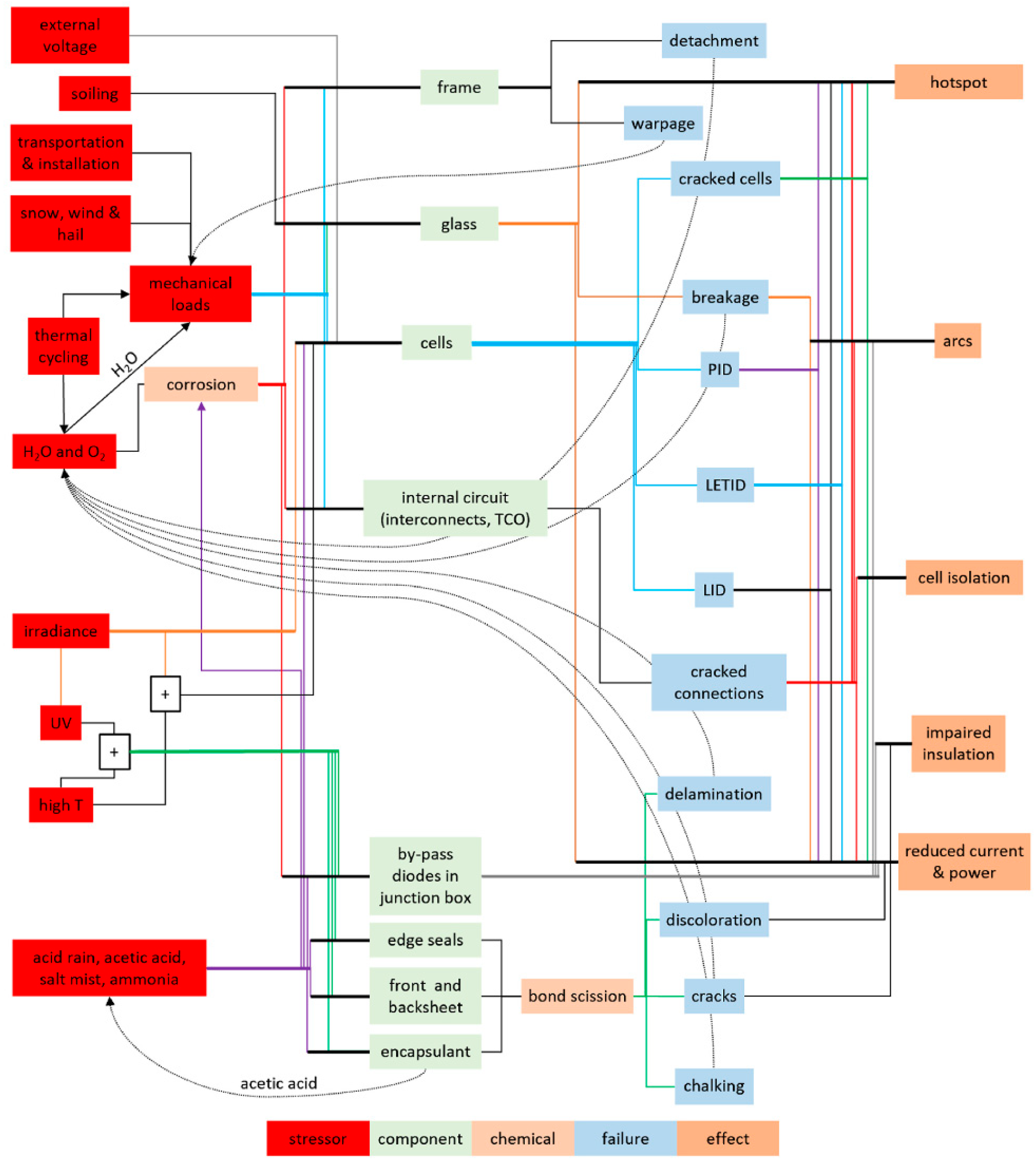
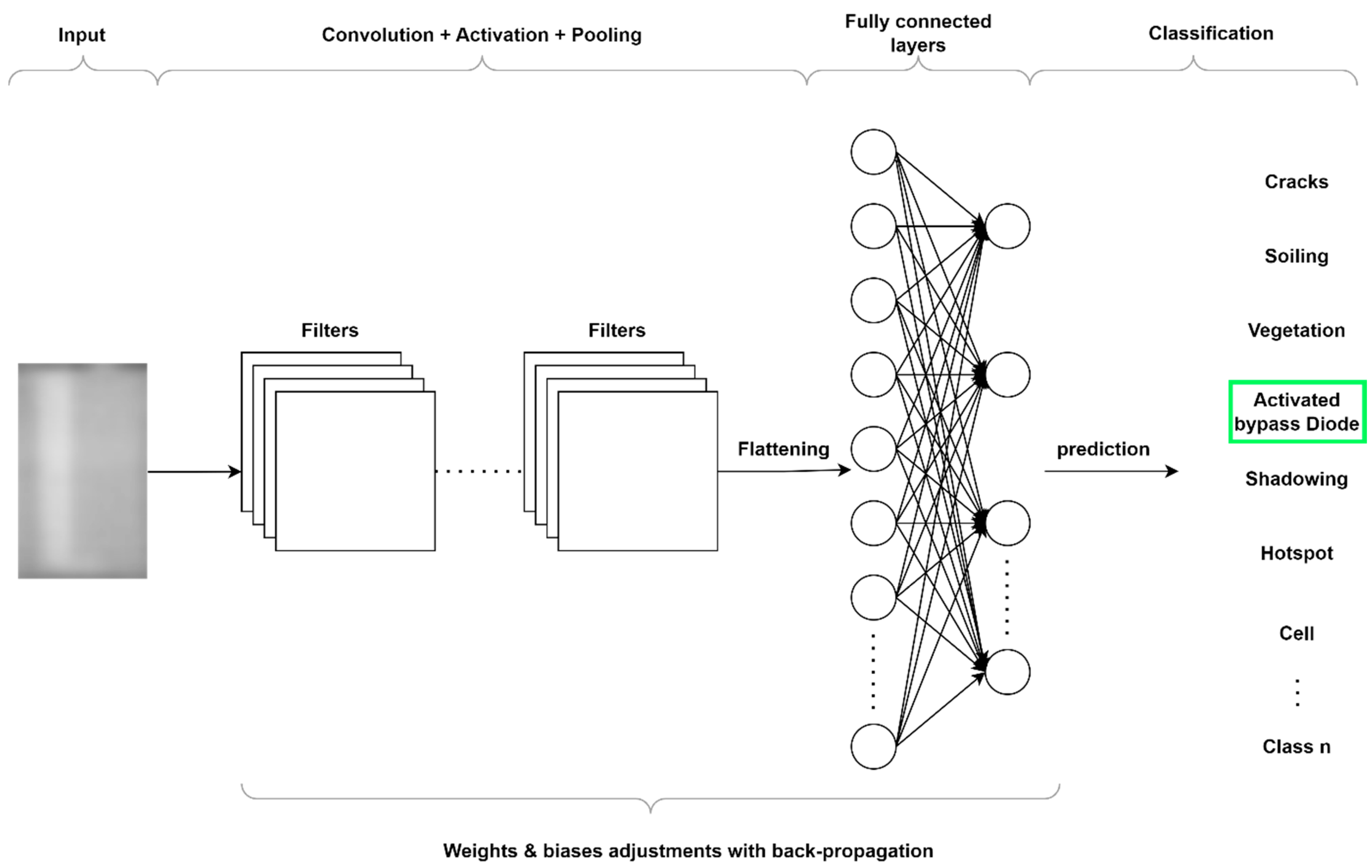
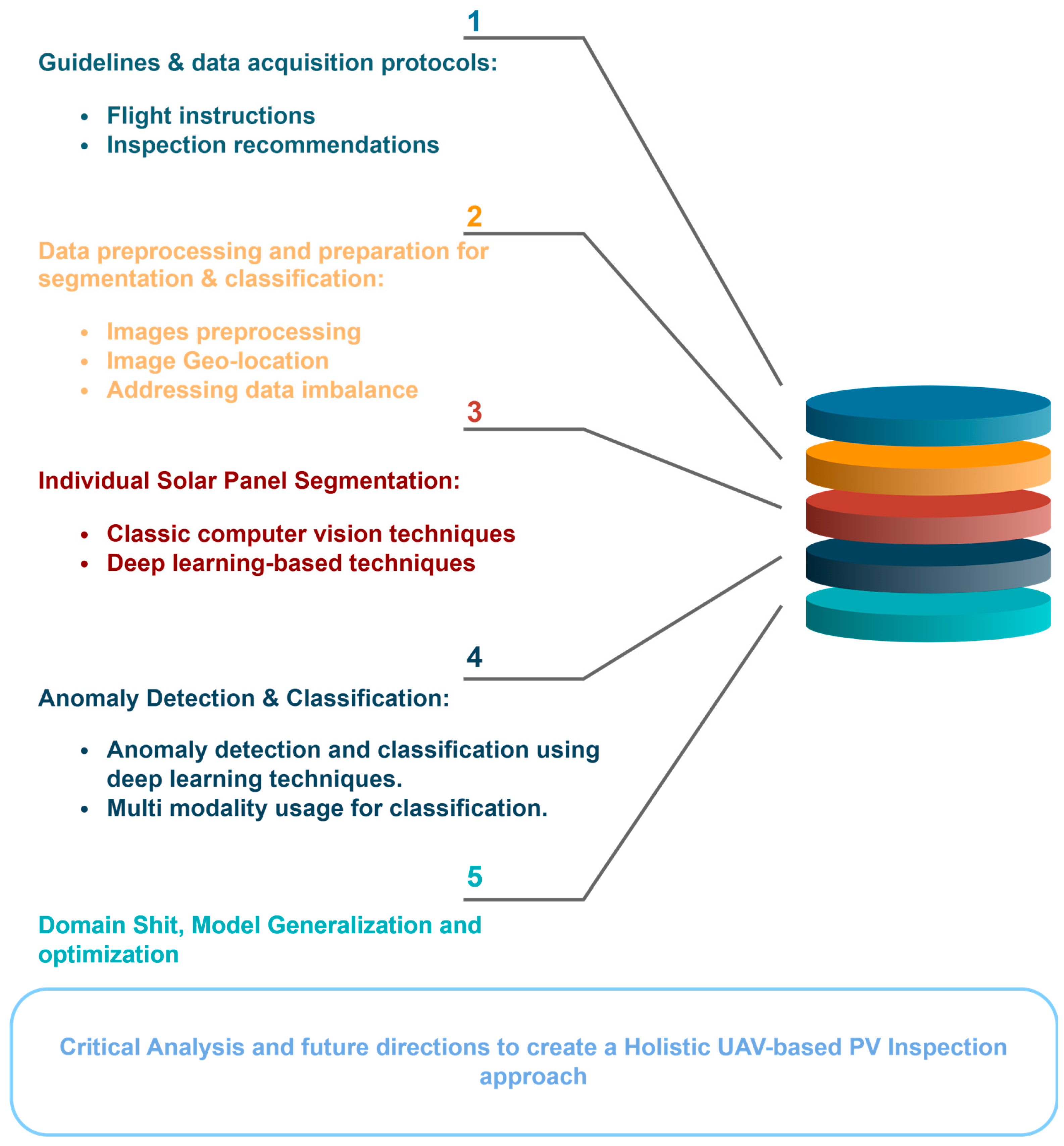
| Anomaly | Description | Image Appearance | Image Type for Detection |
|---|---|---|---|
| Cracks and micro-cracks | Cracks can occur during installation and maintenance or because of the climate (snow and ice pellets). Mechanical and thermal stress can cause cracks in the panel’s surface [22]. Soldering during production can damage the ribbon, and pressure on the silicon wafers can cause cross-crack lines [21]. In addition, impacts against a rigid object can generate cracks on the edge of the cell. |  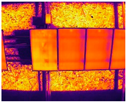 | Thermal images (IR), electroluminescence images (EL), and RGB images |
| Delamination | Deterioration of the back sheet and the encapsulant (ethylene vinyl acetate [EVA]) allows water and oxygen to penetrate the successive layers of the PV module. This problem can be correlated with reduced solar energy transmitted through the system since the system cannot transmit it optically. This causes a problem with heat dissipation and, therefore, an increase in cell temperature [23,24]. | 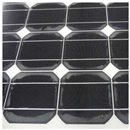 (Image from [25]) | IR–RGB |
| Discoloration | It is a change in the color of the cells towards yellow or brown due to the reduction in the performance of Ethylene Vinyl Acetate (EVA) (chemical reaction), which takes place due to UV radiation combined with water at a temperature of 50 °C. It can also occur due to prolonged exposure to high temperatures and low quality of the encapsulant [17]. This affects the transmittance of the system and, therefore, reduces its production. |  | IR–RGB |
| Shading | Shading, which can be caused by buildings, trees, dust, or even snow, reduces the radiation received by the system and, therefore, energy production. This causes high-temperature cells and hotspots. The temperature is lower in partial shading than in total shading [24]. |   | IR–RGB |
| Soiling | Dust accumulation has a reduced effect on performance, but can worsen if not dealt with promptly. A dust storm can reduce system output by 20% and reach 50% if not cleaned [26]. |  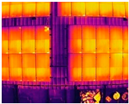 | IR–RGB |
| Activated diode bypass | The bypass diode solves the interconnection problem. The diode can malfunction due to increased temperature [8]. In this case, the fault can be seen in the thermal image when 1/3 or 2/3 of the module is hotter than the other parts of the same module [27,28]. | 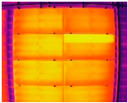 | IR |
| Short circuit | Short-circuited cells result from interconnection faults. They manifest themselves on thermal images by one or more rows being hotter than the others in the same panel [28] and by a patchwork of overheated cells spread across the short-circuited module [25,29]. | 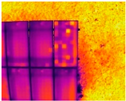 | IR |
| Hotspots | Hotspots occur when a cell produces less energy than the cells in the exact string [30]. They are not explicitly linked to specific defects, but they do warn of failures such as delamination points, cracks due to mechanical stress, corrosion, soldering defects, and others [31]. | 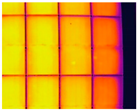 | IR |
| Offline module | Interruption of a complete string or panel connection to the system due to fuse connection failures or junction box problems prevents many modules from being switched on [31]. | - | IR |
| Cells | The panel’s hot region has the cell’s shape in the module. This could be due to shadowing, a defect in the cell, or delamination, which requires visual inspection to detect the probable cause [25]. |  | IR–RGB |
| PID | This is distinguishable when cells closer to the frame are warmer than those in the middle [25]. |  | IR |
| Aspect | Study | Method | Advantages/Gaps |
|---|---|---|---|
| Data | [75] | Data augmentation (for anomalous classes), Undersampling (by discarding the dominant class in the multiclass classification) | The multiclass classifier discarded the normal class. |
| [73] | Class weighting, Data augmentation, SMOTE | Lower accuracy in minority classes; potential overfitting with SMOTE. | |
| [74] | Data augmentation (for anomalous classes), Undersampling (by discarding the dominant class) | The multiclass classifier discarded the normal class. | |
| [76] | Data augmentation | Potential model bias due to insufficient variations (big difference in number between classes). | |
| [104] | - | Model bias towards shadowing due to image quantity; reduced performance in multiclass classification. | |
| [29] | Combination of undersampling, augmentation, and oversampling | It is a complex implementation and may not solve significant gaps between class frequencies. | |
| [79] | Cascading decision system | Takes advantage of the decision made on lower levels of classification, handling balanced classes; this improves the classification made in the multiclass classification. | |
| Domain shift | [111] | GenPV to mitigate the domain shift by training on different resolutions and photovoltaic module sizes Uses feature pyramid networks to resolve imbalances in resolution | Results revealed poor performance on unaligned datasets. |
| [61] | Contrastive learning | Large datasets from different environments are required to achieve better results. | |
| [80,90] | The dataset comprises four distinct sites | Lower performance on unseen data than on mixed dataset encompassing all sites. | |
| [91] | - | They affirm that the model should be evaluated for its generalization capacity when applied to an expanded dataset. | |
| [112] | Data-based domain generalization: data acquisition from different photovoltaic sites and in different environmental conditions | Improves models generalization toward unseen data, ensuring efficient inference in real-world settings | |
| [113] | Production-ready strategy with a retraining cycle for DL models to improve future inference | Improvement of the model using production environment data. However, there is a need to study the impact of newer data on performance. | |
| Solar panel segmentation | [81] | String detection uses Sobel and Canny detectors to detect individual modules within strings | Classical computer vision techniques are not generalizable. |
| [82] | Geometric properties and rectangular shapes of modules to detect single modules | The rectangular shape of panels is not generalizable to other datasets. | |
| [84] | Find peaks function in MATLAB | Classical computer vision techniques are not generalizable. | |
| [66] | Automatic thresholding using Otsu | A good attempt to try automatic thresholding; however, it is still not generalizable. | |
| [63] | RGB images converted to HSV + geometric properties (i.e., circumference) and shape to eliminate background noise | The properties of the panels depend on their shape in the image, which can be difficult to generalize. | |
| [80] | filtering and geometric properties of the solar panel + SVM to eliminate false positives | Missing panels and geometric properties based on image measurements | |
| [80] | Mask R-CNN + SVM to eliminate false positives | outperformed the classical, but required labeled data. | |
| [87] | Yolov3 for solar panel segmentation from thermal images | Fast inference is suitable for real-time detection, but requires labeled data. | |
| [90] | R-CNN on tiled visual orthomosaics | Photogrammetric preprocessing and labeling are required. | |
| Geolocation | [71] | ORB key point detection and RANSAC for outliers’ removal | Localize each detected panel by its ID. |
| [69] | Module’s ID linking to the plant ID to localize each image | Computational requirements not adapted for real-time application. | |
| [29,68] | Photogrammetric processing | Computational requirements not adapted for real-time application. | |
| [70] | Photogrammetric processing | Not suitable for real-time application. | |
| [60] | SFM–MVS to rectify the geolocation errors | Image stitching is required before inspection for fault detection. | |
| [69] | Classical image processing for module segmentation and two CNNs for the detection and classification of RGB and thermal images, respectively | Localization in image space and not geographical localization. | |
| Anomaly classification | [118] | Multimodal classification in large-scale photovoltaic systems | The multimodality concerns only the features extracted from the electrical data. |
| [60] | Two CNNs to classify anomalies in RGB and IR images | The combination of IR and RGB models was only used to cross-validate the decision of both models. | |
| [109] | Three models for the classification of RGB, IR, and meteorological data | The weighting makes the final decision of these models. There is no interpretation of the correlation between modalities. | |
| [89] | Yolov5 and ResNet for the segmentation of panels and their classification through RGB and IR images | Both modalities are processed separately. | |
| [88] | Yolov3 to segment solar arrays and classify faults in RGB and thermal images | Only one modality was used for this study. However, it produces a model with low inference for segmentation and classification. | |
| [101] | U-DenseNet based on DenseNet and U-Net combination for 12-class dataset classification | Proposed GAN for data augmentation to cure data imbalance; focuses only on IR modality. | |
| [105] | AlexNet for feature extraction, J48 for feature selection, and four stacked ensemble machine learning models for the classification | Interest only in visual faults such as discoloration. | |
| [119] | Yolov7 for anomaly classification | Interest in deployment in the production environment and the optimization needed was not studied adequately for real-world settings of PV plants. | |
| [73] | Residual blocks-based CNN to classify 12-classes dataset of thermal images and 15 model ensemble models | Several models’ combinations for the classification of anomalies, with an accuracy of 88%. | |
| [59] | Comparison of the detection and classification of images acquired by a handheld camera and a UAV | UAV image classification produced better results. | |
| [72] | Modified SSD by changing the backbone with VGG16 to detect faults in RGB images | ||
| [26] | Combined RGB and environmental factors as inputs to predict power loss, dirt location, and dirt type | ||
| [104] | Applied VGG16 for feature extraction only and then the SVM classifier for five anomaly classifications in RGB images | Binary classification outperforms multiclass classification in terms of performance. | |
| Holistic approach | [88,114] | Provided a workflow for segmentation and classification using thermal and RGB images | The multimodality was not studied, and both modalities were processed separately. |
| [69] | SunMap as a solution for unattended maintenance methods for PV plants | Based on statistical analysis of the thermal response to detect hotspots; used photogrammetric processing for segmentation and localization. | |
| [99] | IoT-based approach for image classification based on Firebase and Raspberry Pi | The implementation assumed the images were stored in Firebase and did not perform segmentation. | |
| [117] | Two-step analysis starting with the array’s segmentation, followed by hotspot detection using CNNs | They have provided a platform for uploading images to process and display results. However, they adopted a Single modality (IR), and no geolocation step was provided to localize anomalies. | |
| [116] | Sensor-based monitoring using five AI models for anomaly detection in multiple plants | The cost is high due to the need for sensors. |
Disclaimer/Publisher’s Note: The statements, opinions and data contained in all publications are solely those of the individual author(s) and contributor(s) and not of MDPI and/or the editor(s). MDPI and/or the editor(s) disclaim responsibility for any injury to people or property resulting from any ideas, methods, instructions or products referred to in the content. |
© 2025 by the authors. Licensee MDPI, Basel, Switzerland. This article is an open access article distributed under the terms and conditions of the Creative Commons Attribution (CC BY) license (https://creativecommons.org/licenses/by/4.0/).
Share and Cite
Barraz, Z.; Sebari, I.; Ait El Kadi, K.; Ait Abdelmoula, I. Towards a Holistic Approach for UAV-Based Large-Scale Photovoltaic Inspection: A Review on Deep Learning and Image Processing Techniques. Technologies 2025, 13, 117. https://doi.org/10.3390/technologies13030117
Barraz Z, Sebari I, Ait El Kadi K, Ait Abdelmoula I. Towards a Holistic Approach for UAV-Based Large-Scale Photovoltaic Inspection: A Review on Deep Learning and Image Processing Techniques. Technologies. 2025; 13(3):117. https://doi.org/10.3390/technologies13030117
Chicago/Turabian StyleBarraz, Zoubir, Imane Sebari, Kenza Ait El Kadi, and Ibtihal Ait Abdelmoula. 2025. "Towards a Holistic Approach for UAV-Based Large-Scale Photovoltaic Inspection: A Review on Deep Learning and Image Processing Techniques" Technologies 13, no. 3: 117. https://doi.org/10.3390/technologies13030117
APA StyleBarraz, Z., Sebari, I., Ait El Kadi, K., & Ait Abdelmoula, I. (2025). Towards a Holistic Approach for UAV-Based Large-Scale Photovoltaic Inspection: A Review on Deep Learning and Image Processing Techniques. Technologies, 13(3), 117. https://doi.org/10.3390/technologies13030117








